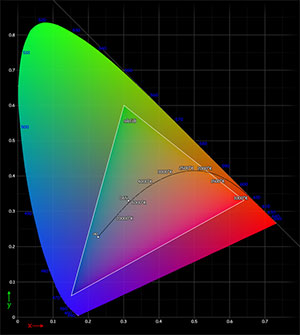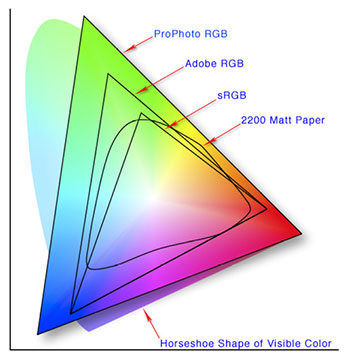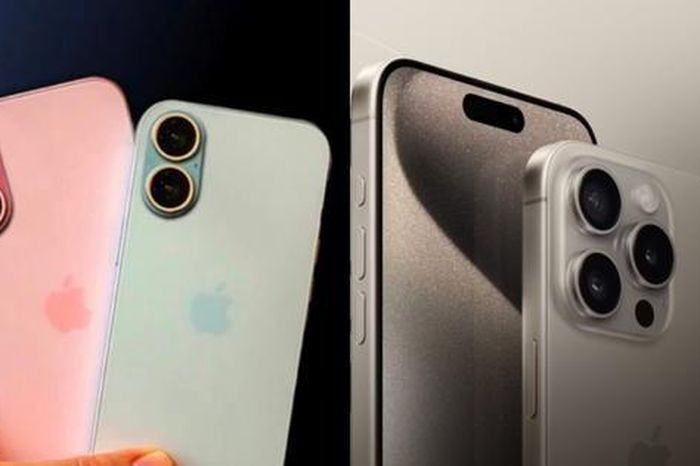What is color space?
A larger color space captures more colors. In this article, let's learn with TipsMake what is color space and how does it really affect?
What is color space?
There are countless ways you can mix colors together. For example, just add a little green somewhere, you get a new color. This is the best way to visualize the color space. Large color spaces have more color combinations than small color spaces.

Color spaces are named after their base color. So you get RGB (Red-Cyan-Cyan), sRGB, and CMYK (Cyan-Magenta-Yellow-Black) color spaces. If you look at the color chart above, the triangle represents the sRGB color space, the color space used on most cameras, computer monitors, and printers.
You'll also see how the sRGB color space fits into the total visible spectrum, which is the larger rounded triangle. Like said earlier, this larger space contains all the different possible combinations of blue and green, red and blue, green and red, or all three. Any color space fits into a larger map of different color combinations.

You may also have heard of a term called gamut. Gamut simply refers to color spaces.
Larger color spaces
In an effort to improve professional-grade image quality, companies have been working on printers, monitors, and cameras that can handle larger color spaces. Two of those spaces are the Adobe RGB and ProPhoto color spaces. If you look at the diagram below, you can see how they stack up against the standard RGB (sRGB) color space.

As you can see, they are clearly larger. They cover the entire sRGB space, not excluding any colors in that gamut.
What is the use of shooting in RAW format?
If you set the default format on your camera to JPEG for file processing, the camera is most likely using the sRGB color space. Some cameras allow you to capture JPEG Adobe RGB or ProPhoto RGB images, but you'll need to enter that setting manually. This makes it easier to print photos at the store.
Most commercial printers use the sRGB color space. They can't even print photos directly from the memory card unless they're in this format. So if you want the convenience of printing directly from the card, use sRGB.
If you shoot in RAW, you can choose the color space you want to use later in post-processing (when you use Photoshop on a computer). This is the best possible choice for professional photographers, who have access to high-end monitors and printers that can actually do something with the additional color information. If this description works for you, you probably already know what a color space is and why it matters.
Why should you stick with sRGB for now?
Unless you're a professional photographer working with very demanding clients, there's really no need to work in the larger color space.
You can't buy an affordable computer monitor or printer that works in the Adobe RGB or ProPhoto RGB color spaces. The industry standard is sRGB. Most people viewing your photos on the web won't be able to see all of those additional colors, even if you've taken every measure to distribute them.
Of course, all of this is subject to change when there are some new product announcements, so you have to pay to stay up to date. If monitors operating in the Adobe RGB or ProPhoto RGB space become the norm, it would make sense to start taking pictures of those screens. For the time being, the world is still in the 'stone age' when it comes to colors, so stick with sRGB.
You should read it
- CSS color coding, standard color code in website design
- Standard color encoding for programmers and designers
- 4 software to help get professional color codes
- 4 apps that change hair color in photos on iPhone
- Tools to get colors online quickly
- The secret to choosing dyed hair color that matches skin color
- Color Impact: color scheme helps you
- 11 interesting facts about ISS International Space Station not everyone knows
May be interested
- The secret to choosing dyed hair color that matches skin color
 choosing the right hair color for your skin color is quite difficult. however, if you know which hair color is 'standard' for your skin tone, everything will be simple and effective.
choosing the right hair color for your skin color is quite difficult. however, if you know which hair color is 'standard' for your skin tone, everything will be simple and effective. - Color Impact: color scheme helps you
 there are times when you have difficulty choosing colors for your designs? with color impact, you will create extremely unique and impressive color palettes.
there are times when you have difficulty choosing colors for your designs? with color impact, you will create extremely unique and impressive color palettes. - Revealing the design of the iPhone 16 series, the Pro version will have 2 new color options
 leaked information shows that the camera system of the iphone 16 and iphone 16 plus will be more compactly designed, similar to the iphone x generation. the iphone 16 pro line will have two new color options: rose and space. black.
leaked information shows that the camera system of the iphone 16 and iphone 16 plus will be more compactly designed, similar to the iphone x generation. the iphone 16 pro line will have two new color options: rose and space. black. - Color command in Windows
 the color command changes the foreground and background colors in the command prompt window for the current session. if used without parameters, the color command restores the default foreground and background colors of the command prompt window.
the color command changes the foreground and background colors in the command prompt window for the current session. if used without parameters, the color command restores the default foreground and background colors of the command prompt window. - How to color images in Photoshop
 on photoshop, there is a simple color filler and photo filler tool.
on photoshop, there is a simple color filler and photo filler tool. - How to use screen color filters in Windows 11
 similar to older versions of windows, windows 11 also includes built-in color filters, to help people with vision problems or color blindness have a comfortable, full experience. more complete.
similar to older versions of windows, windows 11 also includes built-in color filters, to help people with vision problems or color blindness have a comfortable, full experience. more complete. - Deeply understand Color in CSS
 css supports up to 140 colors with unique names and lots of colors under the values of hex, rgb, rgba, hsl, hsla.
css supports up to 140 colors with unique names and lots of colors under the values of hex, rgb, rgba, hsl, hsla. - 15 designs of a modern white kitchen with elegance, looking mesmerizing
 if you are a cooking lover, you will probably be interested in designing the kitchen for it to be beautiful. with 15 models of luxurious white modern kitchen, the look is mesmerizing to help you easily choose.
if you are a cooking lover, you will probably be interested in designing the kitchen for it to be beautiful. with 15 models of luxurious white modern kitchen, the look is mesmerizing to help you easily choose. - 11 interesting facts about ISS International Space Station not everyone knows
 international space station or international space station (abbreviated as iss) is a complex of works to study the space launched into space in 1998.
international space station or international space station (abbreviated as iss) is a complex of works to study the space launched into space in 1998. - How to enable Auto Color Management for applications in Windows 11
 auto color management is a new windows feature that improves the color quality of digital images and makes them look more natural. it's almost like having an exclusive color specialist in place right at your fingertips.
auto color management is a new windows feature that improves the color quality of digital images and makes them look more natural. it's almost like having an exclusive color specialist in place right at your fingertips.










 What is the Desktop.ini file? How to hide and delete Desktop.ini file on Windows
What is the Desktop.ini file? How to hide and delete Desktop.ini file on Windows What is a TIB file? How to ghost a computer with a standard .tib file UEFI - GPT
What is a TIB file? How to ghost a computer with a standard .tib file UEFI - GPT What are OBB files? How to open the OBB file
What are OBB files? How to open the OBB file What is the difference between TPM 1.2 chip and TPM 2.0 chip?
What is the difference between TPM 1.2 chip and TPM 2.0 chip? What is Google Scholar? Instructions on how to use Google Scholar
What is Google Scholar? Instructions on how to use Google Scholar What is VVC (Versatile Video Coding)?
What is VVC (Versatile Video Coding)?